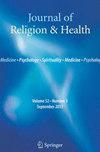Does Religiosity Reduce Mortality Risk Over the Second Half of Life Among Southern Californians? A Multidimensional Model Within a Hazard Modeling Framework.
IF 2.2
1区 哲学
Q2 PUBLIC, ENVIRONMENTAL & OCCUPATIONAL HEALTH
引用次数: 0
Abstract
This study explored the relationship between a multidimensional typology of religiosity and risk of mortality. Using data from middle-aged Southern California respondents in the Longitudinal Study of Generations, we performed latent class analysis to construct a typology of religiosity, which was then used to predict mortality from 1971 to 2020. We identified four religiosity classes: strongly, weakly, privately, and liberally religious. Cox proportional hazard models revealed that privately religious males had greater mortality risk than strongly religious males, even after controlling for the mediators self-rated health and psychological wellbeing. In women, risk of mortality was explained by these mediators rather than by religiosity.
信仰宗教能降低南加州人后半生的死亡风险吗?危害建模框架中的多维模型。
本研究探讨了宗教信仰的多维类型与死亡风险之间的关系。利用南加州中年受访者在 "世代纵向研究"(Longitudinal Study of Generations)中的数据,我们进行了潜类分析,构建了宗教信仰类型学,然后用它来预测 1971 年至 2020 年的死亡率。我们确定了四个宗教信仰等级:强烈宗教信仰、弱宗教信仰、私人宗教信仰和自由宗教信仰。Cox 比例危险模型显示,即使在控制了自评健康和心理健康这两个中介因素后,私下信教的男性比强烈信教的男性有更大的死亡风险。在女性中,死亡风险是由这些中介因素而不是宗教信仰来解释的。
本文章由计算机程序翻译,如有差异,请以英文原文为准。
求助全文
约1分钟内获得全文
求助全文
来源期刊

Journal of Religion & Health
Multiple-
CiteScore
5.40
自引率
21.40%
发文量
220
期刊介绍:
Journal of Religion and Health is an international publication concerned with the creative partnership of psychology and religion/sprituality and the relationship between religion/spirituality and both mental and physical health. This multidisciplinary and interdisciplinary journal publishes peer-reviewed original contributions from scholars and professionals of all religious faiths. Articles may be clinical, statistical, theoretical, impressionistic, or anecdotal. Founded in 1961 by the Blanton-Peale Institute, which joins the perspectives of psychology and religion, Journal of Religion and Health explores the most contemporary modes of religious thought with particular emphasis on their relevance to current medical and psychological research.
 求助内容:
求助内容: 应助结果提醒方式:
应助结果提醒方式:


